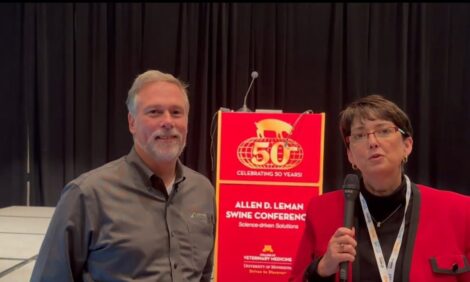



NA PRRS Symposium: monitoring for emerging swine diseases
The North American PRRS Symposium was held recently to look at new swine disease research and try to tackle not only porcine reproductive and respiratory syndrome (PRRS) virus but other emerging diseases as well."PRRS is probably one of the number one domestic diseases that we see and that producers face, so it is a big concern because it's something that is a very severe challenge for pork producers,” said Dr Lisa Becton, Director of Swine Health Information and Research at the National Pork Board. “Meetings like this help to get new and recent information out about what's going on regarding vaccine development, understanding the virus, and coming up with solutions about if a farm does break, how do we address and deal with it.”
The National Pork Board continues to research the PRRS virus and support industry efforts to find solutions to the disease. Other industry entities are also researching the virus, creating a coordinated effort to try to understand how it works and changes and to discover solutions.
“There is always a tonne of new information at this symposium because as our knowledge continues to evolve, people get very excited about new ways to try to manage the virus,” said Dr Becton.
Emerging diseases to watch
There are several emerging diseases that researchers are monitoring.
“Obviously, PED is probably the biggest one that comes to mind to people, and that occurred in 2013, and it still does give us some issues here in North America and is something we're very concerned about,” she noted. “Seneca Valley Virus, or Seneca A Virus, had a reemergence back in 2015, but we're also concerned about African swine fever, especially with the infection announced last year in China. We're also always concerned with things like classical swine fever and foot-and-mouth disease virus because those also can affect pigs.”
Pig producers should continuously monitor for emerging diseases by watching out for changes in the herd. Adhering to basic biosecurity is a must - monitoring people that come into and out of your farms, making sure any incoming animals have been through an isolation period and tested to ensure they don’t have any existing diseases.
“Another thing that's hugely important is looking at sanitation of vehicles, like farm vehicles, personnel vehicles, feed trucks and live haul trucks. Adequate cleaning and disinfection is really, really important on those vehicles,” she explained.
“From the research side, we're really trying to focus on accurate and timely diagnosis, because obviously we can't act on a disease if we don't know it's there, so that's something, as an industry, is a very coordinated and collaborative effort. We are also looking at vaccines and other mitigants for these types of viruses and that's ongoing work.”
Industry collaboration
Because the threat of emerging diseases is bigger than any one group, entity or organisation, it’s important that the industry seek out partners and work with collaborators.
“We may be working on one focus area, and another group may be working on a different focus area, but when we merge the two together, we have the ability to really cross a larger cross section of addressing these diseases,” said Dr Becton. “To pool our resources and merge our ideas and work together make the most sense to help benefit producers overall.”







